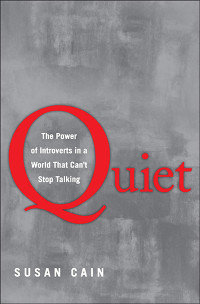We all behave differently depending on the situation
 Quiet: the Power of Introverts in a World that Can’t Stop Talking
Quiet: the Power of Introverts in a World that Can’t Stop Talking
by Susan Cain
I had been looking forward to this book for a long time. I watched and enjoyed Cain’s TED talk about introversion and I have seen many positive reviews. Perhaps I had overhyped the book to myself, but in the end I was disappointed – I felt the book was trying to be too many things and didn’t quite hit the mark.
As the title suggests, this book is about people who are quiet, or introverted. An author’s note acknowledges that Cain has followed the popular conception of introversion as an all-encompassing label for quiet people, rather than using one of the various scientific descriptions. (Personally I think that information would have been useful in the main text.)
“We all behave differently depending on the situation. But if we’re capable of such flexibility, does it even make sense to chart the differences between introverts and extroverts? Is the very notion of introversion-extroversion too pat a dichotomy…Aren’t we all a little of both?”
The book runs through the faces of introversion from psychology, sociology and medicine/biology to self-help, careers guidance and parenting advice. Some of these faces were more interesting to me than others (read: I dislike self-help) but it did feel like the net was thrown a little too wide, meaning each subtopic was only briefly dealt with, when often I would have liked more detail. Between the broader topics is a series of case studies that Cain herself has compiled from visits and interviews.
Cain grounds every claim in scientific studies and I was fascinated to learn the various ways in which we have begun to understand what exactly introversion is, how nature and nurture interact to create it and how some cultures have a leaning towards introvert or extrovert deeply embedded. However, I felt that she wasn’t really interested in the science and so skimmed past the bits that I most wanted to hear more of.
“After all these years of evidence that conventional brainstorming groups don’t work, they remain as popular as ever. Participants in brainstorming sessions usually believe that their group performed much better than it actually did, which points to a valuable reason for their continued popularity – group brainstorming makes people feel attached. A worthy goal, so long as we understand that social glue, as opposed to creativity, is the principal benefit.”
Where Cain’s writing works well is in discussing business/management (her own speciality) and her investigations/case studies, partly because she chose some really interesting paths to follow. She visits Harvard Business School, a massive Californian evangelical church organisation and a self-confidence guru who runs hugely successful – and expensive – seminars. The Harvard visit I actually found depressing because the school’s leaders seem to fundamentally misunderstand the world and demand extroversion from their students, refusing to acknowledge decades of evidence that introverts can also make great leaders.
There is a huge US bias to this book. Its very thesis – summed up by the subtitle – is based on US culture in corporations and increasingly also schools being heavily biased towards extroversion. From how kids are taught to how offices are laid out, Cain’s argument is that the US does not acknowledge the value that introverts bring and that society in general is missing out on a lot of great stuff that way. Which, as an introvert, is reassuring and even empowering to hear, but the rest of the world isn’t the US and the problems we face are not all the same.
“We perceive talkers as smarter than quiet types – even though grade-point averages and SAT and intelligence test scores reveal this perception to be inaccurate…We also see talkers as leaders. The more a person talks, the more other group members direct their attention to him, which means that he becomes increasingly powerful as the meeting goes on.”
And here we reach the thing that really began to get on my nerves. Rather than acknowledge that this book is solely about America, Cain introduces some comparisons between ethnic groups and between countries. But not all countries (or even continents) or ethnic groups are considered. In fact, just two are: white Americans and Asians. That’s right – generic Asians. Never mind that Asia is the largest and most populous continent on Earth. Cain takes dozens of studies that each look at people in one or two specific countries, or even cities, and each time describes the results as US versus Asia.
Which apart from being maddening left me with so many more questions than I had to begin with. There is actually lots of extra information, particularly about the studies, in notes at the end of the book but that’s not an easy format to read and I would have preferred a little more of it incorporated into the main text. Perhaps an acknowledgement of the book’s limitations would have gone some way to endearing it to me.
Published 2012 by Crown.
Source: Amazon.
Interesting thoughts on Quiet. I got about half way through and was enjoying it, but got distracted and never picked it up again. I think the culture thing would have irritated me, too. And her science certainly was very biased. But I still found it interesting and will try it again.
Yes, it certainly made me think and kept me reading to the end. I by no means think it’s a bad book. But there were times those little irritations got to me!